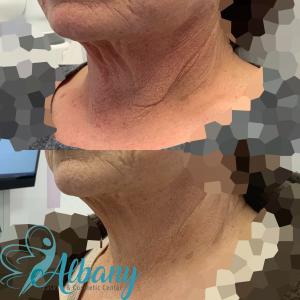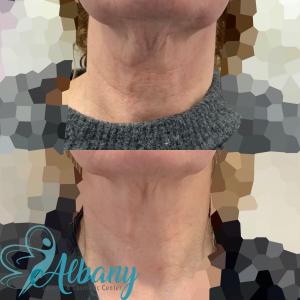Non-Surgical Neck Tightening
Laser Neck tightening uses bulk and gradual heating to tighten the skin on the neck and Jawline. According to Dr. Kamal Alhallak, a cosmetic expert in Edmonton,
EDMONTON, ALBERTA, CANADA, April 1, 2022 /EINPresswire.com/ -- Laser Neck tightening uses bulk and gradual heating to tighten the skin on the neck and Jawline. According to Dr. Kamal Alhallak, a cosmetic expert in Edmonton, it's one of the most effective ways to tighten loose, saggy skin in the neck area."After the age of 30, our collagen and elastin synthesis decreases—two proteins that help our skin remain firm, full, and toned," he adds. "lasers direct energy into the skin, penetrates to deeper layers to encourage the creation of collagen and elastin, gradually improving the texture and tone."
According to Alhallak, lasers may be used to treat loose skin on the face, neck (and chin), décolletage, stomach, thighs, and almost any other body area. However, not all lasers are created equal—what may work well on the buttocks to correct stretch marks and cellulite. Moreover, lasers may be the ideal choice for tightening the undereye region.
Laser tightening is a non-invasive, non-surgical procedure that is quite painless. Phew! Apart from little discomfort caused by the heat generated by the lasers during the operation, skin tightening is almost painless. You may even like the sensation of heat, which Dr. Alhallak compares to "a hot stone massage."
Laser is not the only way of providing non-surgical skin tightening. There are three primary techniques other than lasers for neck tightening.
Even though there are hundreds of "brand name" neck tightening treatments, according to Alhallak, they all fall into three broad categories: ultrasound, radiofrequency, and radiofrequency microneedling.
Ultrasound
Ultrasounds are not reserved for pregnant women. According to Alhallak, ultrasonic cosmetic treatments (Ulthera is the most often used brand name) are particularly helpful for individuals wanting a substantial lift. "[The ultrasonic approach] concentrates ultrasound energy to heat the skin at a greater level than other modalities, allowing for deeper tightening and lifting," He explains. "The treatments are administered by a portable device that emits ultrasonic waves. You can often get away with only one or two sessions spaced apart—depending on your level of plasticity."
Ultrasound equipment sends High-Intensity Focused UltraSound (HIFU) to the deep layers of skin being heated to ensure that you get the lift you want. Consider doing it over your lunch break since it will only take 45-90 minutes. However, a word of caution: You will require patience: "After three months, you start to see the biggest results," Nussbaum says. "You will see an instant rise, but the greatest outcome will take three months."
Cost: $1200–$6,000, depending on the body area
Radiofrequency
Additionally, radiofrequency employs a portable device to heat the skin to tighten it. "We use radiofrequency to stimulate collagen formation to heat the skin more superficially." There is very little, if any, downtime. As with ultrasound treatments, it may be rather hot—similar to a hot stone massage. Additionally, it is a slow procedure; although you may be in and out of the clinic in less than an hour, you will typically need two to six treatments (depending on the extent of the region being treated, given seven to ten days apart)" Alhallak elaborates.
Cost: from $600-to $1,000, depending on the body area
Microneedling using radiofrequency
That is not the traditional microneedling you are referring to. Rather than performing the procedure with a microneedling pen, Alhallak asserts that the radiofrequency microneedling instrument is more akin to a stamp. "This is not your average pen-based microneedling. It's an energy stamper equipped with 37 gold-plated needles," he clarifies. "Rather of damaging the epidermis and causing micro-tears as with microneedling, you stamp the skin to produce minute holes that then radiate radiofrequency to tighten the layers." However, this treatment has a longer downtime when compared with other treatment modalities.
Cost: from $600-to $1,000, depending on the body area
"I often tell my patients that the advantage of non-surgical tightening is that there is little to no downtime...but it is also progressive," Dr. Alhallak says. You must wait for the production of collagen and elastin. As a result, most patients need a few treatments spaced out with little or no downtime. Thus, all that is required is patience." Patients may suffer mild redness and soreness in the region treated with ultrasound and radiofrequency. Radiofrequency microneedling is the only therapy that requires actual post-care (if that is a word)
Dr. Kamal alhallak
Albany Cosmetic and Laser Centre
+1 587-520-2835
email us here
Fotona Neck Tightening
Legal Disclaimer:
EIN Presswire provides this news content "as is" without warranty of any kind. We do not accept any responsibility or liability for the accuracy, content, images, videos, licenses, completeness, legality, or reliability of the information contained in this article. If you have any complaints or copyright issues related to this article, kindly contact the author above.



